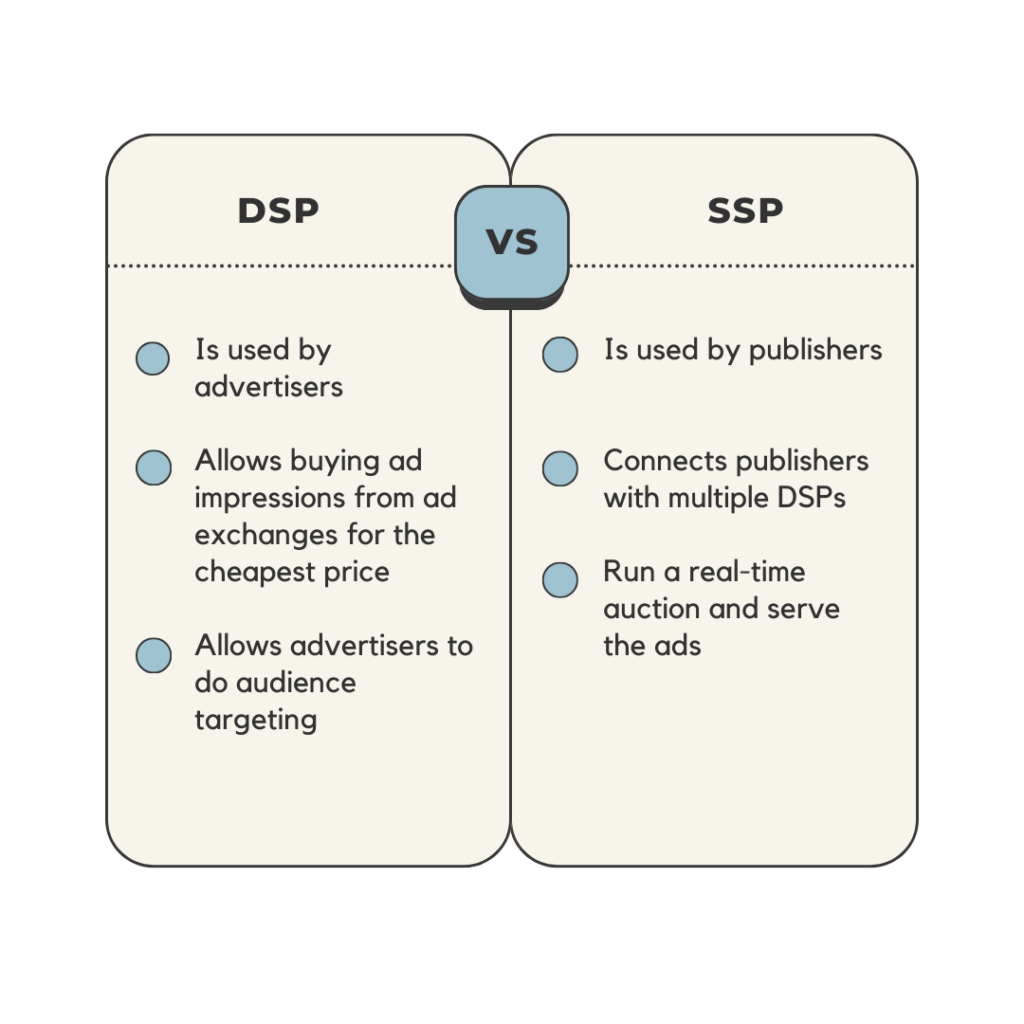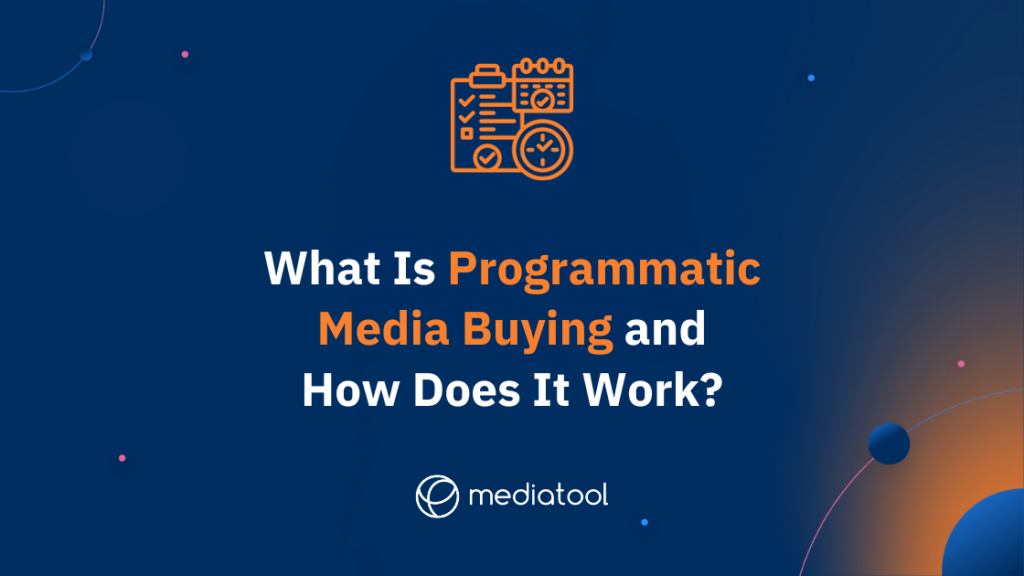What is Programmatic Media Buying?
Programmatic media buying refers to the automated process of purchasing digital ad inventory through technology platforms, such as Demand Side Platforms (DSPs) and Supply Side Platforms (SSPs).
This approach to online advertising replaces the traditional method of manual buying and selling, allowing advertisers and publishers to buy and sell ad space more efficiently. Programmatic media buying utilizes real-time data, ensuring ads are shown to the right target audience at optimal times.

What is the difference between programmatic advertising and display ads?
While programmatic and display ads often intersect, they aren’t the same. Display ads are a type of online advertising format, like banner ads or video ads. They can be bought and sold traditionally or through programmatic methods.
On the other hand, programmatic advertising refers to buying and selling ad space, whether for display ads, native ads, or other digital advertising formats.
Display ads are the visual content audiences see on websites, including images, videos, and text. They play a crucial role in the advertiser’s marketing strategy by being the vehicle that carries the brand message to the target audience.
On the other hand, programmatic advertising is the behind-the-scenes process that decides where and when these display or video ads are shown. Programmatic advertising emphasizes the strategic placement of these ads using data management platforms to ensure maximum reach and impact.
Buying and Selling: Auction Types for Programmatic Advertising
With the global programmatic advertising spending expected to reach 725 billion by 2026, it’s evident that this form of advertising plays a crucial role in the digital landscape. However, it’s not without its challenges.
This year alone, the expenditure on ad fraud by advertisers is projected to hit a staggering $84 billion, underscoring the pressing need for transparency and security in programmatic transactions.
When it comes to programmatic advertising, there are several auction types:
- Open Auctions: This is the most common type of programmatic ad buying, where any advertiser can bid for ad space on multiple ad exchanges.
- Private Marketplaces: Unlike open marketplaces, private marketplaces restrict participation to select advertisers.
- Preferred Deals: Publishers offer ad space at a fixed price, bypassing the auction.
- Programmatic Guaranteed: Advertisers guarantee the purchase of a specific number of ad impressions from a publisher at a set price.
Open Auctions democratize the ad buying process, making ad inventory available to a wide range of advertisers, big or small. Advertisers use Demand Side Platforms (DSPs) to participate in real-time bidding on these open ad exchanges.
In contrast, Private Marketplaces (PMPs) provide an exclusive environment where publishers can invite specific advertisers or agencies to bid, offering premium ad inventory. Preferred deals and programmatic guaranteed bypass the traditional auction model.
While preferred deals allow advertisers to buy ad space at a predetermined price, programmatic guaranteed ensures that advertisers secure a certain amount of premium ad inventory upfront, providing visibility and placement.
How Does Programmatic Advertising Work?
Programmatic advertising works by leveraging technology platforms and data. Advertisers use Demand Side Platforms (DSPs) to purchase digital ad inventory. Conversely, publishers use Supply Side Platforms (SSPs) to sell their ad inventory.
Through real-time bidding (RTB), ad space is auctioned in milliseconds. The advertiser willing to pay the highest price wins the auction, and the ad is immediately displayed to the user.
Integrating these technologies ensures a seamless and efficient way to buy and sell digital display advertising space, making programmatic advertising a dominant force in the digital advertising landscape.
Why Choose Programmatic Advertising?
Programmatic advertising offers numerous advantages:
- Efficiency: The automated buying process eliminates manual negotiations and paperwork.
- Precision: With access to real-time data, advertisers can target specific audiences, ensuring relevancy.
- Flexibility: Advertisers can adjust campaigns in real time based on performance.
- Scale: Access to a vast digital advertising space across the internet.
- Cost-Effectiveness: The cost of programmatic advertising can often be lower than traditional methods due to the precision and real-time adjustments.
Beyond these advantages, programmatic advertising uses advanced algorithms and machine learning, enabling advertisers to refine their campaigns and optimize return on investment. As the ad buying process becomes more sophisticated, advertisers can explore programmatic advertising strategies that adapt to real-time events or trends, making campaigns more dynamic and responsive.
Additionally, with the increasing concerns about ad fraud in the digital ecosystem, leading programmatic advertising platforms have integrated advanced measures to combat such activities, ensuring that the advertiser’s budget is spent on genuine ad impressions.
Is Real-Time Bidding a Form of Programmatic Buying?
Yes, real-time bidding (RTB) is a form of programmatic ad buying. It’s a process where ad impressions are bought and sold in real-time auctions that happen in milliseconds. As a user loads a webpage, available ad space is auctioned, with advertisers bidding for that space. The highest bidder wins, and their ad is displayed.
In the RTB model, both the advertisers and publishers benefit. Advertisers have the advantage of reaching a targeted audience in real time, thereby increasing the chances of user engagement. On the other hand, it allows publishers to maximize their revenue by selling their inventory to the highest bidder. The real-time nature of this process allows for dynamic pricing, which often leads to higher revenues for publishers and more precise ad placements for advertisers.
Demand-Side Platform (DSP)
A Demand-Side Platform (DSP) is a technology platform that allows advertisers to buy ad inventory from multiple ad exchanges in an automated fashion. It offers tools for targeting, bidding, and optimizing programmatic ad campaigns.
The sophistication of DSPs has evolved considerably over the years. Modern DSPs are integrated with vast amounts of data, enabling advertisers to make more informed decisions regarding their ad placements. Through features such as frequency capping, geo-targeting, and third-party data integration, DSPs offer a more granular approach to targeting specific audiences, making digital marketing campaigns more effective and efficient.
Transparency
One of the significant benefits of programmatic advertising is transparency. Advertisers can see where their ads are placed, the programmatic advertising cost, and their real-time performance. This transparency helps refine programmatic advertising strategies and ensure optimal spending of the advertising budget.
Understand Your Target Audience
Programmatic advertising enables advertisers to understand and target their audience better. Using data management platforms, advertisers can segment their audience based on various criteria such as behavior, demographics, and interests. This precise targeting ensures that ads reach the most relevant users, enhancing campaign performance.
Beyond traditional data points like age, gender, or location, new technological advancements and integrations allow advertisers to uncover more.
Insights into user behavior, purchase histories, or content preferences can further refine audience targeting. This richer understanding can lead to more personalized advertising, resonating better with users and improving conversion rates.
Why Programmatic Advertising is Important for Advertisers
Programmatic advertising is reshaping the digital advertising landscape. It offers a more efficient way to buy and sell ad inventory, leveraging real-time data for precision targeting. As the digital world becomes more complex, with users spread across various platforms, programmatic advertising provides a unified solution, ensuring advertisers get the best value for their money.
Notably, programmatic digital display advertising spend is projected to make up 91.5% of all digital display ad spend in 2024, highlighting the significant shift and trust in this advertising method.
Beyond efficiency, programmatic advertising democratizes the advertising realm. Even smaller advertisers with limited budgets can enter the market, targeting their niche audiences precisely. This level playing field allows for more competition, innovation, and a broader array of creative marketing strategies. As a result, users experience a wider variety of ads tailored to their preferences.
Programmatic Media Platforms
Various platforms are involved in programmatic advertising, including DSPs, SSPs, ad exchanges, and data management platforms (DMPs). These platforms work together to automate ad-buying, connecting advertisers to relevant audiences and publishers to potential buyers.
As this type of programmatic advertising grows, the platform ecosystem also expands. Each platform plays a distinct role. For instance, Supply Side Platforms (SSPs) allow publishers to manage and sell their ad inventory, optimizing for maximum revenue.
Meanwhile, Data Management Platforms (DMPs) aggregate and analyze vast amounts of data, providing valuable insights advertisers can use to refine their campaigns. The harmonious interaction between these platforms is essential for the seamless functioning of the programmatic advertising process.
In recent years, the integration of artificial intelligence (AI) into programmatic platforms has paved the way for more sophisticated and efficient advertising strategies. It is anticipated that by the year 2028, the market for programmatic advertising powered by artificial intelligence will have grown to an impressive $38.67 billion.
What Platforms Sell Programmatic Ads?
Platforms that sell programmatic ads are primarily Supply Side Platforms (SSPs). These platforms allow publishers to manage, sell, and optimize their ad inventory across multiple exchanges. Popular SSPs include Google Ad Exchange (AdX), Rubicon Project, and OpenX.
Supply-Side Platform (SSP)
An SSP is a technology platform that enables publishers to manage and sell their ad inventory to advertisers on programmatic and display ad platforms. It ensures maximum revenue for publishers by optimizing ad impressions and connecting them to multiple ad exchanges.
Mobile Ad Exchanges
Mobile ad exchanges are platforms where mobile ad inventory is bought and sold. These exchanges allow advertisers to target users on mobile devices, tapping into the growing mobile audience.
With the increasing reliance on mobile devices for online activities, the importance of mobile ad exchanges has grown. They enable real-time bidding on mobile ad inventory, ensuring that ads are displayed to the right target audience at the right time. This ensures that advertisers can maximize their reach and engagement while maintaining the efficiency and cost-effectiveness of their programmatic ad campaigns.
What is the difference between an SSP and a DSP?

While SSPs and DSPs play crucial roles in the programmatic advertising process, they cater to different users. Advertisers use a DSP to buy ad space, while publishers use an SSP to sell their ad space. Essentially, DSPs demand ad inventory, while SSPs supply it.
A DSP enables advertisers to bid on ad inventory across multiple ad exchanges, optimizing their programmatic ad buying based on data and analytics. On the other hand, an SSP helps publishers manage their available ad space and optimize the selling price based on demand.
What Are The Benefits Of Programmatic Advertising?
The benefits of programmatic advertising include:
- Targeted Reach: Reaches specific audiences based on real-time data.
- Efficiency: Automates the ad buying process, saving time and resources.
- Real-time Analytics: Provides instant feedback on ad performance.
- Flexibility: Campaigns can be adjusted in real time.
- Cost-effective: Reduces wastage by targeting only relevant audiences.
Additionally, programmatic advertising reduces the risks of ad fraud. Through advanced verification techniques and third-party integrations, these platforms ensure that ads are displayed to genuine users, not bots. This leads to more genuine engagements and better ROI for advertisers.
Data Management Platform (DMP)
A DMP is a technology platform that collects, organizes, and analyzes data from various sources. Advertisers use DMPs to understand their audience and create detailed segments for targeting. It’s integral to programmatic advertising, ensuring relevant and effective ads.
Beyond just gathering data, DMPs are pivotal in synthesizing vast amounts of information into actionable insights. By analyzing data from multiple sources, including first-party and third-party data, DMPs enable advertisers to develop more nuanced and detailed programmatic campaigns and advertising strategies, enhancing the efficacy of their digital marketing efforts.
Leverage Data
In programmatic advertising, data is king. Leveraging data allows advertisers to decide where, when, and how to display their ads. Advertisers can deliver more personalized and effective ad campaigns by analyzing user behavior, interests, and demographics.
The rise of big data and machine learning has further amplified the role of data in programmatic advertising. Advanced algorithms analyze vast datasets, predicting user behavior and preferences. This not only aids in effective targeting but also programmatic advertising trends anticipating market trends and shifts, allowing advertisers to stay ahead of the curve.
What Is the Google Ad Exchange (AdX)?
Google Ad Exchange (AdX) is a major platform for buying and selling digital ad space. It’s a part of the Google Display Network, allowing advertisers to access a vast inventory of websites and apps. AdX operates in real-time, with advertisers bidding for ad space based on their targeting criteria.
Beyond the standard display ads, AdX also supports various formats like video ads, native ads, and banner ads. This diversity allows advertisers to create more engaging and immersive user ad experiences.
Ad Exchangers
Ad exchangers are platforms that facilitate the buying and selling of ad inventory. They connect advertisers and publishers, ensuring optimal ad placements and maximum revenue. Examples of ad exchanges include Google Ad Exchange, AppNexus, and MediaMath.
Open marketplaces
Open marketplaces are digital spaces where any advertiser can bid for ad space. They provide a broad reach, accessing multiple websites and apps. The buying process in open marketplaces is transparent, with advertisers bidding in real-time.
Are Google Ads Programmatic?
Yes, Google Ads utilize programmatic technology, especially those on the Google Display Network. Advertisers bid for ad space in real time, targeting specific audiences based on various criteria.
Private marketplaces
Private marketplaces (PMPs) are exclusive digital spaces where select advertisers can bid for ad space. Publishers invite specific advertisers to participate, ensuring more control over who displays ads on their platform.
While PMPs offer a more controlled environment, they come with the advantage of premium ad placements and high-quality inventory.
Top-tier publishers often reserve their best PMP ad slots, attracting reputed brands and advertisers looking for high visibility and engagement. This exclusivity often results in higher bid prices, but the returns regarding audience quality and engagement are often worth the premium.
How Much Does Programmatic Advertising Cost?
Programmatic advertising costs vary based on factors such as ad format, targeting criteria, and competition. Generally, advertisers set a budget and bid for ad space. The highest bidder wins the ad impression. Due to the efficiency and precision of programmatic advertising, it often provides a better return on investment than traditional advertising methods.
What is header bidding?
Header bidding is an advanced programmatic technique that allows publishers to offer their ad inventory to multiple ad exchanges simultaneously before making calls to their ad servers. This ensures maximum yield for each impression, as multiple advertisers can bid on the same ad space.
Mobile DSP
A Mobile DSP is a demand-side platform designed explicitly for buying ad inventory on mobile devices. Given the growing importance of mobile advertising, these platforms provide tools and features tailored to the mobile landscape.
The demand for mobile-focused programmatic platforms has soared. Mobile DSPs offer advanced targeting capabilities, utilizing data points like device type, operating system, and location. As mobile consumption patterns differ from desktop, leveraging mobile DSPs allows advertisers to optimize campaigns, delivering native and video ads effectively to the desired target audience on handheld devices.
What is Programmatic Targeting?
Programmatic targeting refers to using data to display ads to a specific audience. Using data from DMPs, advertisers can target users based on demographics, behavior, interests, and more. This ensures ads are relevant and likely to resonate with the viewer.
Programmatic Advertising Examples
Some examples of programmatic advertising include:
- Users browsing a travel website might see ads for hotel deals or flights based on their search history.
- After looking at sports shoes on an e-commerce website, users might see banner ads for similar products on other websites they visit.

The landscape of programmatic advertising is vast and multifaceted. Beyond travel or e-commerce, consider someone who frequently engages with content related to home gardening. They might encounter programmatic ads showcasing specialized gardening tools, organic seeds, or local gardening workshops. The adaptability of programmatic advertising ensures that users are not only targeted based on their immediate interests but also their evolving passions and curiosities.
Programmatic Ads With Performance TV
Performance TV combines the precision of programmatic advertising with the reach of television. Advertisers can target specific audiences on TV using data, ensuring their commercials are shown to relevant viewers.
With the rise of smart TVs and connected devices, Performance TV has witnessed a surge in dynamic ad insertion. This allows advertisers to replace traditional TV ads with targeted programmatic ads in real time.
For example, two neighbors watching the same live sports game on their smart TVs might see different commercials during the break tailored to their individual viewing habits and preferences. Such advancements highlight blending digital strategies with conventional broadcasting, ensuring that television remains a relevant and potent advertising medium.
DMP vs DSP
While both DMPs and DSPs are essential in programmatic advertising, they serve different purposes. A DMP is primarily about data – collecting, organizing, and analyzing. In contrast, a DSP is about buying – it’s the platform through which advertisers purchase ad space. DMPs are the brains behind the operation, providing the necessary intelligence and insights.
At the same time, DSPs act as the execution arm, enabling the actual purchase of ad space based on the insights from the DMP. When integrated seamlessly, DMPs and DSPs work in tandem to drive successful programmatic campaigns, with the DMP ensuring the right target is identified and the DSP ensuring the ad reaches that target efficiently.
Conclusion
Programmatic advertising is revolutionizing the digital landscape, providing an efficient, data-driven way to buy and sell ad space. By leveraging Demand Side Platforms (DSP) and Supply Side Platforms (SSP), advertisers and publishers can seamlessly participate in real-time bidding (RTB) on multiple ad exchanges, optimizing their online advertising strategies. Display ads, including banner ads and videos, are often the visual representation in this process.
Still, the underlying programmatic ad-buying process ensures these ads reach the right target audience. Integrating data management platforms enriches this process, offering detailed insights for precise targeting.
The benefits of programmatic advertising are manifold – from cost-effectiveness to real-time analytics and adaptability. As more advertisers recognize the potential and cost of programmatic advertising, the emphasis on transparency, combating ad fraud, and maximizing ad inventory across various platforms will only grow.
Whether you’re new to online advertising or seeking to refine your marketing strategy, understanding and leveraging the power of programmatic advertising is essential for modern marketers.





